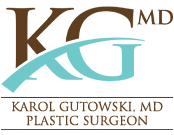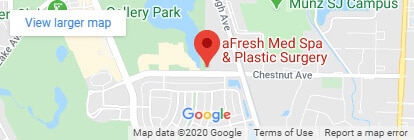Facelift – Rhytidectomy in Greater Chicagoland (Glenview)
OVERVIEW
The gold standard in dramatic age reversal has long been the facelift, which lifts and tightens the entire face. The aged and saggy skin, muscles, and fat are repositioned to restore a youthful and refreshed look. Lines, wrinkles, bags, and droopiness are all addressed. Our surgeons at the office of Dr. Karol A. Gutowski believe in a more realistic, natural-looking facelift and we work closely with our patient to achieve the desired look. The ultimate goal of the facelift is to erase years off of the patient’s face and restore lost confidence without the face appearing overly tight or worked on. We offer services to patients in Oakbrook and Greater Chicagoland.
WHAT IS A FACELIFT?
A facelift is a surgical option that can address visible signs of aging by tightening sagging skin and restoring a more youthful appearance. Over time, aging skin naturally loses elasticity, leading to wrinkles, jowls, and deep creases around the mouth and nose. A face lift can help redefine the contours of your face and neck, giving a smoother, refreshed look. It’s a popular choice for those seeking long-term results to combat the natural effects of aging.
WHAT CAN A FACELIFT ADDRESS?
Sagging Skin on the Face and Neck
As we age, the skin on your face and neck loses its natural firmness and elasticity. This can lead to loose, sagging skin that affects your overall appearance. A face lift can tighten this excess skin, giving your face and neck a more youthful and toned look, with techniques that avoid the unnatural “pulled” effect some patients worry about.
Deep Folds Around the Nose and Mouth
The lines that develop between your nose and mouth, also called nasolabial folds, tend to deepen over time. If these folds are making you look older than you are, a face lift can help soften them. By addressing both the skin and underlying tissue, we can reduce the depth of these folds, creating a smoother transition between different areas of your face.
Jowls and Pre-Jowl Folds
With aging, the natural fat and structure of your face start to shift downward, leading to the formation of jowls along the jawline. These pre-jowl folds can make your face look heavier and less defined. A face lift works to lift and reposition the tissue.
Loss of Facial Contour
As we age, the natural contours of your face—like your cheekbones and jawline—can become less defined due to volume loss and skin laxity. A face lift not only tightens the skin but also repositions the deeper tissues to create more youthful contours.
REVIEWS
SURGICAL TECHNIQUE
The technique used during a facelift is dependent on the patient’s facial features and conditions. Most surgeons will always aim for the less invasive technique, but some patient cases are severe and will require internal tissues, fat and skin to be manipulated. Patients must also understand the procedure in detail, including the level of invasiveness, placement of incisions, what layers of tissues will be corrected, and what risks may be associated with the surgery before moving forward.
SKIN-ONLY FACELIFT?
Also referred to as the cutaneous facelift, this technique removes excess and loose skin to create a tightened look. The remaining skin is repositioned to lift sagging cheeks and jowls. It also improves the profile along the jaw line. With this facelift technique, the muscles or fat tissues are left untouched. As the treatment focuses on the skin only, recovery is quick. This is ideal for those who still have good tone muscle and distribution of fat, but find the skin losing elasticity in some areas.
TRADITIONAL FACELIFT (SMAS)
SMAS is the superficial musculoaponeurotic system, which is a muscle complex that is primarily active when it comes to facial expression. With normal wear-and-tear due to age, gravity and personal habits, muscle tissue loses its form and becomes displaced significantly for those over 50. This particular facelift is considered the standard when it comes to this cosmetic procedure. With lengthy incisions on the side of the face, from the temple to the lower hairline behind the ear, the skin will be peeled and lifted to reshape contours. If there is excess fat and skin, these will also be removed.
DEEP PLANE LIFT
For those who have severe cases of drooping and skin folds that are normal with aging and extensive sun exposure, a deep plane lift may be the best approach. This is especially true for those whose facial profiles need extensive reshaping on areas that typically have the volume and tight contours. This involves a highly specialized skill set and the plastic surgeon must be carefully selected as the nature of procedure has a high chance of damage to the facial nerves.
MINI FACELIFT
Also called as a short-scar facelift because of the shorter incisions made, a mini lift is a quick treatment that corrects the middle and lower face. Many patients initially consider this technique, but this doesn’t correct any severe issues and usually renders short-term results. Patients who undergo this procedure are most likely to also stage a full facelift as a final step to fully rejuvenate and reshape the face to its youthful curves.
DURING/AFTER SURGERY
Before Your Surgery
Before your face lift surgery, we’ll take the time to ensure you’re fully prepared and comfortable with the process. You’ll have a pre-operative consultation where we’ll discuss your goals, go over your medical history, and outline the surgical plan. We may also take photos for reference and explain any pre-surgery instructions, like avoiding certain medications or foods. It’s important to follow these guidelines closely to ensure the best possible results.
During and After Your Surgery
All facelift procedures are performed in an accredited surgical facility with general anesthesia. Even though this is considered an outpatient procedure, there are some cases where the patient stays overnight for monitoring. It is normal to experience bruising and swelling after the surgery, and patients will feel as if their face is being pulled tight. This subsides within a couple of weeks. Optimal results will be evident after several months. It is important that activities are limited to help create a safe and quick healing.
After your face lift, bandages will be placed around your face to help minimize swelling and bruising. You may also have small drains to remove any excess fluids that can accumulate during healing. Some discomfort is normal, but we’ll provide you with detailed instructions on how to manage pain and take care of your incisions, and when to call us for any concerns. Keep the area clean and follow our advice on caring for the incisions to promote smooth healing.
TIPS FOR A SMOOTH RECOVERY AND BEST FACELIFT RESULTS
Set Up Your Recovery Area
Before your surgery, prepare a comfortable recovery space at home. Have essentials like pillows, blankets, medications, and water within easy reach. You’ll want to rest and avoid unnecessary movements, so creating a cozy spot with everything you need will make the recovery process much smoother. Don’t forget to have a good selection of entertainment, like books or shows, to keep you relaxed during the first few days.
Sleep With Your Head Elevated
After your facelift, sleeping with your head elevated reduces swelling and promotes healing. We recommend using extra pillows or even a recliner to keep your head above your heart. This helps minimize fluid buildup in the face and speeds up your recovery.
Keep Moving, But Avoid Intense Exercise
While rest is important, gentle movement is also crucial for proper healing. Light walking helps prevent blood clots and improves circulation. However, it’s essential to avoid any intense exercise or bending over for the first weeks of recovery.
Continue Avoiding Smoking and Other Unhealthy Habits
If you stopped smoking before your surgery, it’s important to continue avoiding it throughout your recovery. Smoking can slow down healing and lead to complications. Maintaining healthy habits like proper hydration, a balanced diet, and avoiding excessive alcohol will support your recovery and help you achieve the best possible results from your facelift.
Limit Sun Exposure
After your facelift, your skin will be more sensitive to the sun, and exposure can affect your healing and cause unwanted discoloration. Make sure to wear a wide-brimmed hat and apply sunscreen whenever you go outside, even if it’s just for a short time.
FACELIFT FAQS
Am I a Good Candidate for a Facelift?
You may be a good candidate for a facelift if you are in good physical and mental health. Ideal candidates don’t have any serious medical conditions that could interfere with healing, and they are emotionally prepared for the process and the recovery. It’s also important that you’re able to commit to the aftercare and follow post-operative instructions closely.
When Can I Return to Work After a Facelift?
Most patients can return to work about 10 to 14 days after their facelift. By this time, much of the swelling and bruising should have subsided, and you may feel more comfortable being in public. If your job involves physical activity, we may recommend waiting a little longer to ensure your recovery isn’t interrupted.
What Are Some Non-Invasive Alternatives for Facelift Surgery?
Cosmetic surgery is constantly evolving and always finding ways to minimize the invasiveness of procedures. There are countless options that are considered less invasive than a facelift, including wrinkle relaxers such as BOTOX®, injectable fillers, microdermabrasion and chemical/laser peels. These alternatives aim to correct signs of aging such as wrinkles, as well flatten and soften folds and contours. The effects, while effective, are often short-term lasting about six months to a year. Although these procedures can be safely repeated, for some, a facelift may be a better, more permanent option.
Will My Face Look Natural After My Facelift?
Immediately following a facelift procedure, the patient will feel tightness and a pulling sensation. This is normal as the facial tissues, skin and muscle adjust to their new positions. It is important to choose a reputable plastic surgeon that has years of experience in facial cosmetic surgery. A doctor with experience in facial surgery will create natural, smooth results that will last for years to come.
Will I Have Visible Scars After My Facelift?
A traditional facelift requires a long cut from the temple to the lower hairline, but the scars will be well concealed within the hairline and natural creases on the face. With the lesser invasive techniques, the scars heal pretty well and will almost be completely invisible to the naked eye.
What Is the Best Age to Get a Facelift?
Anyone can consider a facelift as soon as evidence of aging starts taking a toll on the skin. Generally, patients who are aged 50 to 70 consider a facelift. Personal habits and environmental conditions can impact the skin and there are patients who are only 40 that are also good candidates for a facelift.
Learn More About Our Facelift Surgeries Today
A facelift can effectively restore a more youthful appearance, addressing sagging skin, deep folds, and loss of facial contour. With the expertise of Dr. Karol A. Gutowski, patients can benefit from advanced techniques that focus on long-term, natural-looking results. Based in Oakbrook, Greater Chicagoland, we serve a wide range of patients looking to enhance their appearance through surgical and nonsurgical facial rejuvenation. For more information about how we can help call us at (847) 906-1527 or contact us online.





 PLAN YOUR PROCEDURE
PLAN YOUR PROCEDURE




